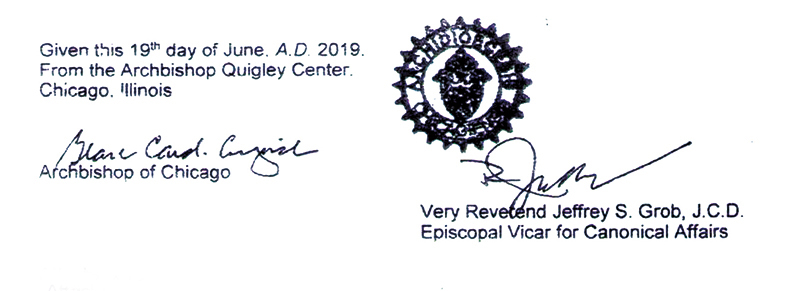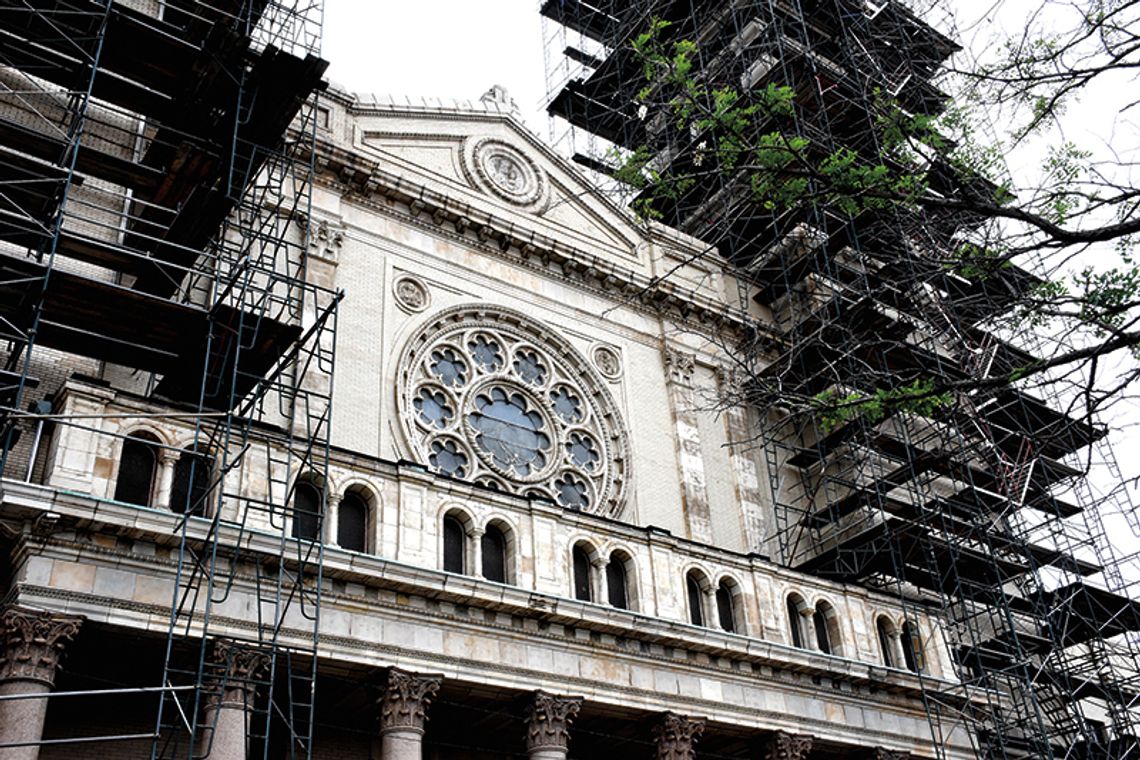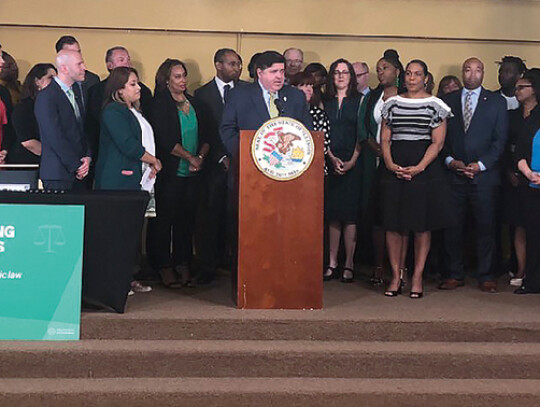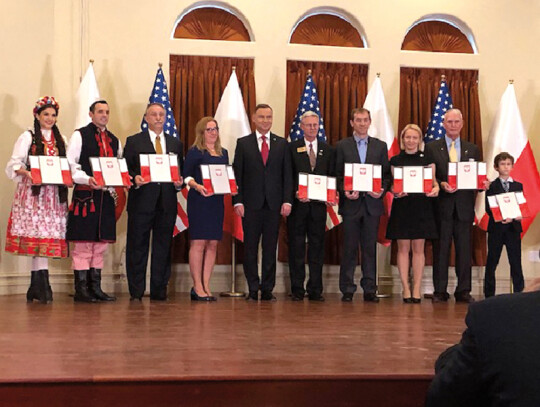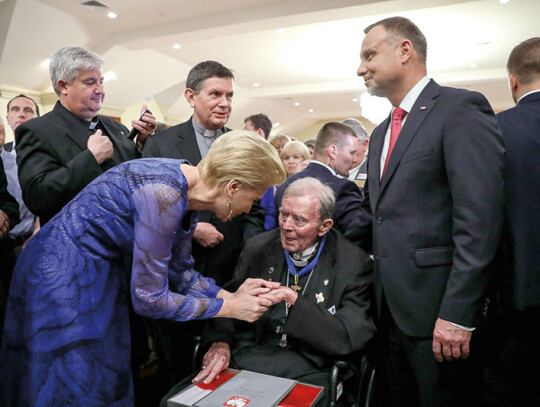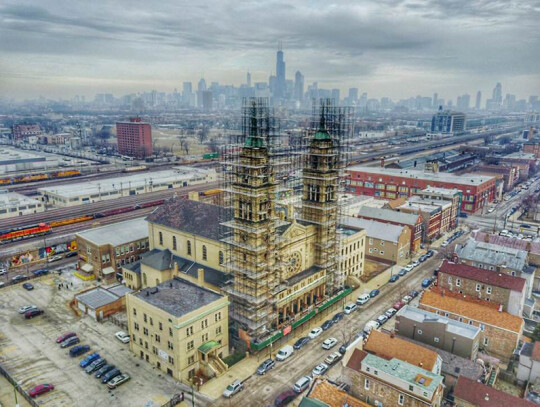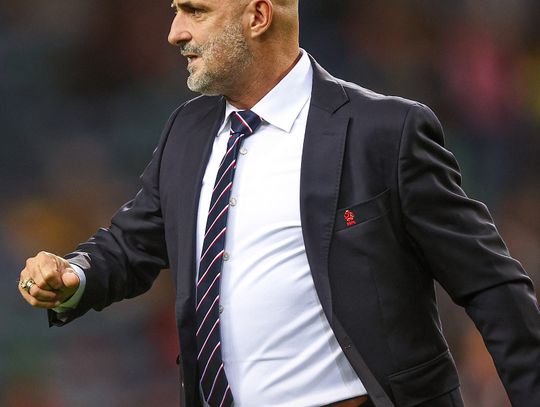 Archidiecezja Chicagowska poinformowała w niedzielę 23 czerwca na swojej stronie internetowej, że od 15 lipca msza św. w kościele św. Wojciecha (St. Adalbert Church) nie będzie odprawiana. Wierni, którzy uczestniczyli w niedzielnej mszy, otrzymali ulotki z dekretem kardynała Cupicha. Mimo tej wiadomości Polonia nie traci nadziei na uratowanie świątyni.
Jak stwierdziła w oficjalnym oświadczeniu na swojej stronie internetowej Archidiecezja Chicagowska, kardynał Blase Cupich wydał dekret dotyczący dalszych losów kościoła św. Wojciecha (1650 w. 17th Street) po konsultacji z radą prezbiterialną. W myśl dekretu, z dniem 15 lipca gmach kościoła przestanie być miejscem świętym i nie będzie mógł być używany w celach religijnych.
Zgodnie z dekretem kardynała Cupicha, ostatnia msza św. ma zostać odprawiona 14 lipca br. w kościele św. Wojciecha (St. Adalbert Church) w chicagowskim Pilsen na zachodzie miasta.
Archidiecezja Chicagowska stwierdziła również, że jest świadoma, iż przez ponad 100 lat kościół św. Wojciecha odgrywał wiodącą rolę w rozwoju dzielnicy Pilsen. Jednak, jak zaznaczyła, musi ona równocześnie wziąć pod uwagę ograniczone zasoby parafii w stosunku do znaczących wymagań inwestycyjnych, jakie są konieczne, by wyremontować i zabezpieczyć gmach świątyni.
Jak podkreślono w oświadczeniu, przedstawiciele Archidiecezji Chicagowskiej prowadzą rozmowy z różnymi grupami, które są zainteresowane nabyciem nieruchomości i wszystkie oferty zostaną rozpatrzone z ,,wrażliwością na potrzeby lokalnych i innych zainteresowanych (przyszłością kościoła) społeczności”.
Przypomnijmy, że Polonia chicagowska prowadzi od prawie trzech lat starania o ocalenie przed likwidacją zabytkowego kościoła, wybudowanego przez polonijnych imigrantów. Organizacja pn. Ratujmy Kościół Świętego Wojciecha (Save Saint Adalbert Church) wciąż ma nadzieję na ocalenie świątyni. Trwają rozmowy z kolejnym zakonem, który mógłby objąć zarząd nad kościołem. Wcześniejsze tego rodzaju rozmowy nie przyniosły niestety oczekiwanych rezultatów.
Kościół pw. św. Wojciecha znajdujący się pod adresem 1650 W. 17th Street w dzielnicy Pilsen w Chicago jest architektoniczną perłą. Parafia św. Wojciecha powstała ponad 140 lat temu. Wokół niej koncentrowało się życie społeczne polskich imigrantów. Architektura świątyni urzeka swoim pięknem i historią. Wnętrze świątyni zostało wyrzeźbione w 35 tonach szlachetnego marmuru. Zbudowana została w stylu neoromańskim i zwieńczona dwiema wieżami, na wzór rzymskiej Bazyliki Świętego Pawła za Murami. Polscy historycy sztuki zaliczyli kościół do grupy najpiękniejszych i najbardziej cennych obiektów sakralnych w USA.
Polska msza święta jest odprawiana w kościele św. Wojciecha w każdą pierwszą niedzielę miesiąca o godzinie 8 rano. Cała Polonia zaproszona jest na mszę w języku polskim 7 lipca o godz. 8 rano.
(ao)
Dekret kardynała Blase’a Cupicha w sprawie kościoła św. Wojciecha (oryginalny tekst)
Archidiecezja Chicagowska poinformowała w niedzielę 23 czerwca na swojej stronie internetowej, że od 15 lipca msza św. w kościele św. Wojciecha (St. Adalbert Church) nie będzie odprawiana. Wierni, którzy uczestniczyli w niedzielnej mszy, otrzymali ulotki z dekretem kardynała Cupicha. Mimo tej wiadomości Polonia nie traci nadziei na uratowanie świątyni.
Jak stwierdziła w oficjalnym oświadczeniu na swojej stronie internetowej Archidiecezja Chicagowska, kardynał Blase Cupich wydał dekret dotyczący dalszych losów kościoła św. Wojciecha (1650 w. 17th Street) po konsultacji z radą prezbiterialną. W myśl dekretu, z dniem 15 lipca gmach kościoła przestanie być miejscem świętym i nie będzie mógł być używany w celach religijnych.
Zgodnie z dekretem kardynała Cupicha, ostatnia msza św. ma zostać odprawiona 14 lipca br. w kościele św. Wojciecha (St. Adalbert Church) w chicagowskim Pilsen na zachodzie miasta.
Archidiecezja Chicagowska stwierdziła również, że jest świadoma, iż przez ponad 100 lat kościół św. Wojciecha odgrywał wiodącą rolę w rozwoju dzielnicy Pilsen. Jednak, jak zaznaczyła, musi ona równocześnie wziąć pod uwagę ograniczone zasoby parafii w stosunku do znaczących wymagań inwestycyjnych, jakie są konieczne, by wyremontować i zabezpieczyć gmach świątyni.
Jak podkreślono w oświadczeniu, przedstawiciele Archidiecezji Chicagowskiej prowadzą rozmowy z różnymi grupami, które są zainteresowane nabyciem nieruchomości i wszystkie oferty zostaną rozpatrzone z ,,wrażliwością na potrzeby lokalnych i innych zainteresowanych (przyszłością kościoła) społeczności”.
Przypomnijmy, że Polonia chicagowska prowadzi od prawie trzech lat starania o ocalenie przed likwidacją zabytkowego kościoła, wybudowanego przez polonijnych imigrantów. Organizacja pn. Ratujmy Kościół Świętego Wojciecha (Save Saint Adalbert Church) wciąż ma nadzieję na ocalenie świątyni. Trwają rozmowy z kolejnym zakonem, który mógłby objąć zarząd nad kościołem. Wcześniejsze tego rodzaju rozmowy nie przyniosły niestety oczekiwanych rezultatów.
Kościół pw. św. Wojciecha znajdujący się pod adresem 1650 W. 17th Street w dzielnicy Pilsen w Chicago jest architektoniczną perłą. Parafia św. Wojciecha powstała ponad 140 lat temu. Wokół niej koncentrowało się życie społeczne polskich imigrantów. Architektura świątyni urzeka swoim pięknem i historią. Wnętrze świątyni zostało wyrzeźbione w 35 tonach szlachetnego marmuru. Zbudowana została w stylu neoromańskim i zwieńczona dwiema wieżami, na wzór rzymskiej Bazyliki Świętego Pawła za Murami. Polscy historycy sztuki zaliczyli kościół do grupy najpiękniejszych i najbardziej cennych obiektów sakralnych w USA.
Polska msza święta jest odprawiana w kościele św. Wojciecha w każdą pierwszą niedzielę miesiąca o godzinie 8 rano. Cała Polonia zaproszona jest na mszę w języku polskim 7 lipca o godz. 8 rano.
(ao)
Dekret kardynała Blase’a Cupicha w sprawie kościoła św. Wojciecha (oryginalny tekst)
 Office of the Archbishop
835 North Rush Street
Chicago, Illinois 60611
312.534.8230
archchicago org
Prot. N. 2019 RPU-1
Office of the Archbishop
835 North Rush Street
Chicago, Illinois 60611
312.534.8230
archchicago org
Prot. N. 2019 RPU-1
DECREE IN THE NAME OF GOD. AMEN.
Over the past several decades, many things have changed in this particular church. Changing demographics have affected the size and wealth of the Archdiocese of Chicago and the vitality of her parishes. This is particularly true in the City of Chicago itself, where the total population has decreased by more than 20% since 1970. from 3,366,957 tc an estimated 2,736,000 today. We also have many vacant and underused parochial buildings, and, as elsewhere, fewer priests to pastor our faith communities. For the number of parishes we have, our human and financial resources are spread very thin. According to the US Census Bureau, the Archdiocese of Chicago had an estimated total population of 5914,783 in 2018 The 2018 Annuario Pontifico indicates Chicago had 345 parishes serving a Catholic population of 2,512,000. In 2018 the Archdiocese of Los Angeles had a total population of 11,519,517, with 287 parishes for a Catholic population of 4,362,000, more than twice the number of Catholics per parish than Chicago. In the same year the Archdiocese of New York had 2,656,987 Catholics in 294 parishes, also a much larger parishioners per parish number than in Chicago. A good number of our parishes were founded in the first half of the last century or earlier. Many were established for national, linguistic, or ethnic groups that no longer live in the archdiocese or in the neighborhoods where they once flourished. Too many of our parishes have been unable to support themselves and are receiving financial subsidies from the archdiocese. Between fiscal year 2012 and fiscal year 2018 these subsidies amounted to $144,373,461.00, including $38,171,840.00 to 106 parishes, and $106,201,621.00 to 83 Catholic schools. More than $25.000,000.00 was given in the last two fiscal years alone. Little of this money if any. will be recovered by the archdiocese. The Archdiocese of Chicago cannot continue this level of financial support for parishes and Catholic schools. Our hope and aim are that our parishes will become more vital, that is, active centers of Christian discipleship, evangelical mission, scholarship, and charitable outreach. To achieve this hope, the parishes must be able to support themselves when possible. Following consultation with the Presbyteral Council of the Archdiocese of Chicago, my decree of May 23, 2016, extinguished the separate juridic persons of three parishes within a less than one square mile territory of the Pilsen neighborhood of the Southside of the City of Chicago: St. Adalbert Parish (established in 1874 as a personal parish for Polish-speaking Catholics), 1650 West 17th Street; St. Ann Parish (established in 1903, also a personal parish for Polish-speaking Catholics). 1840 South Leavitt Street; and St Paul Parish (established in 1876 as a personal parish for German speaking Catholics), 2127 West 22nd Place. These parishes were united to form one new parish, retaining the name of St. Paul Parish. Hierarchical and contentious recourse against the decree of May 23, 2016, ultimately resulted in the Definitive Sentence of the Supreme Tribunal of the Apostolic Signatura on January 26. 2019, affirming my decision of extinctive union (Prot. N. 52630/17 CA). The original mission of St. Adalbert Parish to Polish-speaking Catholics continues through a monthly Sunday Mass in the Polish language, a practice which may continue at St. Paul Church in the future. However, in the second half of the 20th Century, Pilsen had become home to a predominantly Spanish-speaking community. Recently. the ethnic makeup of Pilsen has become more diverse as Non-Hispanic Whites, African Americans, people of Asian ancestry, and others of mixed-race settled in the neighborhood. These newer groups are mostly English-speaking The local Polish-speaking Catholics have. for the most part. moved away from the Pilsen neighborhood. Meanwhile, the overall population of the Pilsen neighborhood had declined by approximately 8.310 persons between 2000 and 2015. 19% of the total. Reflecting this decline, the Catholic population also dropped substantially. as reflected in the more that 29% reduction Sunday Mass attendance at the six Pilsen parishes between 2005 and 2015. During the , same period. the average Sunday Mass attendance at St. Adalbert Church dropped to 541, a 53% decrease from 1.465 in 2000. In the last four years the average attendance at Sunday Masses at St. Adalbert Church dropped an additional 9% to 465. In holding the assets and liabilities of the three united parishes. the new St. Paul Parish has been unduly burdened with buildings and costs it cannot reasonably use or afford, notably the ordinary maintenance and other expenses associated with the ownership and use of St. Adalbert Church and St. Ann Church. St. Ann Church was relegated to profane but not sordid use when closed on July 23, 2018. an event that prompted no hierarchical or contentious recourse. St. Adalbert Church of St. Paul Parish, however, has remained open for public worship since the decree of May 23. 2016 Despite a withdrawn attempt to relegate the church to profane but not sordid use, and an attempt to sell the church to a private buyer willing to repair, renovate, and preserve the church for Catholic worship, the buyer never came through, and the church remains open Mass is offered in English and Spanish every Sunday, and in Polish once each month. St. Adalbert Church is a massive ,800-seat edifice built in the grand Italian renaissance revival style. It was designed by architect Henry Schlacks and completed in 1914. For decades, parishioners and other supporters o the church have not provided the financial resources necessary for its ordinary maintenance and operating expenses. Consequently, St. Adalbert Church has been in a very perilous state of repair In 2014 the two church towers were braced with exterior support scaffolding. The towers are built into the structure of the church, sharing foundations with the front facade and side walls. To date, the scaffolding has been necessary to abate a dangerous structure To keep the scaffolding in place, it has cost nearly $2,000,000.00 in monthly rental fees and, recently, in outright purchase costs. This money was not and could not be raised by the parish consequently, the Archdiocese of Chicago r ;d for the scaffolding. Moreover, additional funding is needed to keep the scaffolding in goof.. repair, and to restore and maintain other features of the church not related to the church towers. The scaffolding may be removed safely only when needed repairs are made to the church. These repairs were estimated to cost an additional $3,000.000 00 in 2016. No doubt, this cost has significantly increased over three years, and neither the parish nor the archdiocese can afford it. From before the extinctive union with St. Adalbert Parish, St. Paul Parish had its own premises, including the recently renovated parish church, a neo-gothic marvel also designed by the architect, Henry J. Schlacks, and dedicated in 1899. St. Paul Church seats more than 600 worshippers, more than enough to accommodate those now regularly worshipping in the parish. Recent renovation of St. Paul Church left a debt of more than $10,000,000.00, a debt the parish has not been repaying. Rather, the Archdiocese of Chicago has underwritten the repairs and covered the debt. It is both unrealistic and uncharitable to expect the new St. Paul Parish to support and maintain a church and other structures it cannot use and has no use for. Simply, there are no parochial, archdiocesan, or other ecclesiastical funds available to repair and maintain St. Adalbert Church for divine worship or for any other purpose of the Church. If the repairs are not made within a reasonable period, the scaffolding will no longer suffice to support the structure. At that point the church will become a dangerous nuisance to the community. Over the three years that St. Adalbert Church has been part of St. Paul Parish, the income from those attending Mass there has been about $600,000.00. During the same period, the operating expenses have been $1,304,795.00, including $900,000.00 the archdiocese spent on the scaffolding. There has been no surplus available to pay for these expenses from income generated at St. Paul Church. Since July 1, 2017, the number of sacraments celebrated at St. Adalbert Church has dwindled to two Baptisms, one marriage, and 23 funerals. In 2015 alone, the numbers were 65 Baptisms, eight marriages, and 14 funerals. Five years ago, there were three priests serving the three parishes united to form the new St. Paul Parish, today there is only one priest assigned to serve the new parish, the Reverend Michael P. Enright, Pastor of St. Paul Parish. The law requires a grave cause or causes to justify the relegation of a church to profane but not sordid use (C/C, c. ‘1222 §2). The Supreme Tribunal of the Apostolic Signatura held a grave cause was entirely apparent when there were these factors: (1) a financial burden in preserving a church imposed on a parish from the union of several parishes; (2) a church no longer of service to the pastoral care of the faithful due to changed circumstances; (3) a new parish burdened from the beginning by a huge debt; (4) ready and effective assistance available to the new parish from the sale of a church; (5) a diminishing number of faithful whose donations principally sustain the new parish; and (6) charity and other assistance to the poor being neglected in order to preserve a sacred building (Ministerium lustitiae: Jurisprudence of the Supreme Tribunal of the Apostolic Signature, Montreal: W & L (2011): Prot. N. 24388/93 CA, pp. 526-527). The situation of St. Adalbert Church encompasses all these factors and more. Moreover, there is no governmental support for building or maintaining churches in the USA. Relegation of St. Adalbert Church to profane but not sordid use, according to canon 1222 §2 of the Code of Canon Law, enhances the possibility that the church and other real property assets of the former St. Adalbert Parish would become a source of income for St. Paul Parish, its parishioners, and its missions. The Reverend Michael P. Enright. pastor of St. Paul Parish understands the need and desire to relegate St. Adalbert Church to profane but not sordid use and, with the chairs of the parish pastoral council and the parish finance council. he has petitioned for it. THEREFORE, know that I. Cardinal Blase J. Cupich, Archbishop of Chicago, according to the norm of canons 50 & 51. 127 §§1 & 3. 166. and 1222 §2 of the Code of Canon Law, having convened the Presbyteral Council of the Archdiocese of Chicago at the general meeting of May 28. 2019. at St Giles Parish. Oak Park, and at the special meeting of June 18, 2019, at the 1BEW Hall. Alsip. having heard the Council at the meeting of June 18, 2019, and after invoking the Holy Spirit and satisfying myself that the good of souls will suffer no detriment, now decree the following: 1. Effective July 15. 2019, St. Adalbert Church of St. Paul Parish, 1650 West 17″ Street, City of Chicago. State of Illinois. is relegated to profane but not sordid use; 2. Officials of the archdiocese. in cooperation with the Pastor of St. Paul Parish, must be certain the assets of the former St. Adalbert Parish are secure for the benefit of St. Paul Palish; 3. If Possible, real property assets of the former parish of St. Adalbert are to provide St. Paul Parish with proceeds from the alienation of the assets or income from their rental under lease; 4. The reports given to the Presbyteral Council on this matter, together with the minutes of May 28. 2019. and June 18. 2019. are, when available, to be attached to this decree; and 5. Notification of this decree is to be made to the Pastor of St. Paul Parish and to parishioners through publication on the website of the Archdiocese of Chicago and in the parish bulletin.Before hierarchical recourse may be taken against this decree, a petition to reconsider or amend the decree must be delivered to me at my office within ten (10) useful days from notification of the decree (CIC cc. 1734. 1735. 1737).
